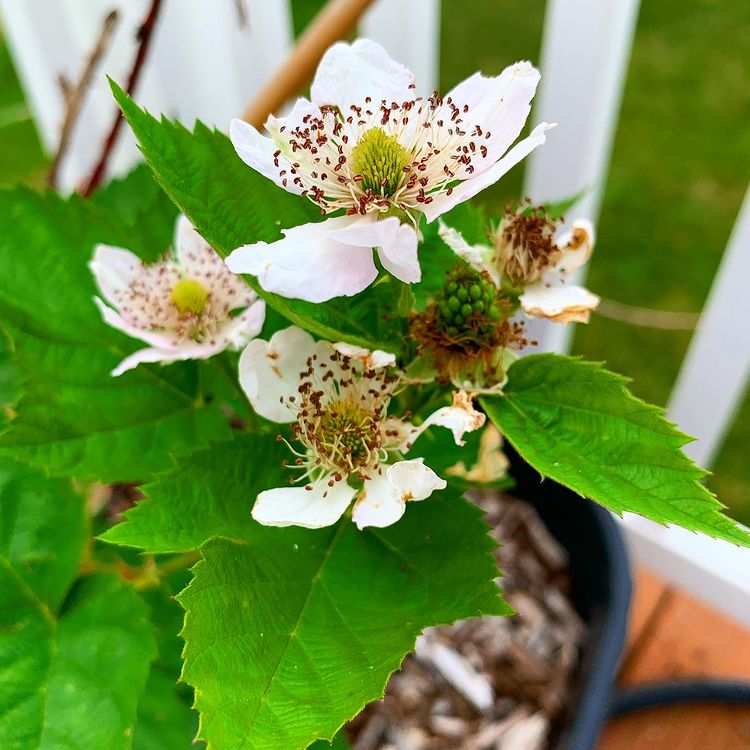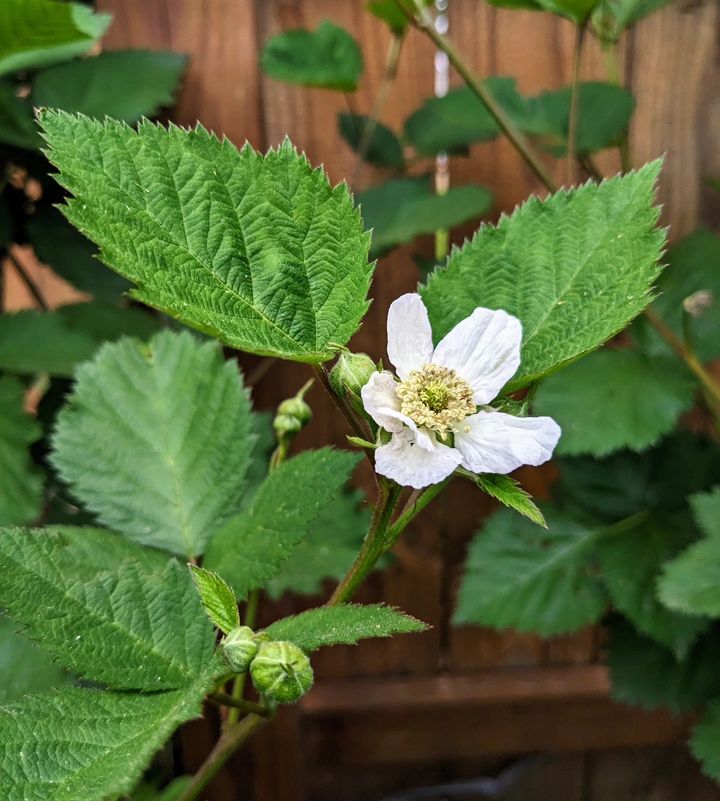Blackberries are a popular fruit that is enjoyed by many. They are known for their sweet and tangy taste, and their versatility in cooking and baking. However, if you are planning to grow blackberries, you may be wondering when they bloom.
Knowing when blackberries bloom is important if you want to get the most out of your harvest.
Blackberries are a type of bramble fruit that typically bloom in the late spring or early summer. The exact time of bloom can vary depending on your location and the specific variety of blackberry that you are growing. In general, blackberries bloom when the weather starts to warm up, and the days get longer.
This usually happens in late April or early May in most parts of the United States. However, in warmer climates, blackberries can bloom as early as March, while in cooler climates, they may not bloom until June.
Bloom Time and Seasonality
When it comes to blackberries, the timing of their bloom depends on several factors, including the weather, the variety of blackberry, and the location where they are grown. Generally, blackberries begin to flower between mid-spring to early summer.
In warmer climates, blooms can be as early as March, while in colder climates, flowering could be delayed until June.
In USDA zones 7 and above, blackberry plants usually produce flowers in mid-April and early May.
However, in colder regions (zones below 7), blackberries start blooming in late May. Therefore, you can choose whether you want early or late-blooming blackberries based on your needs and the hardiness zone where you live.
It is important to note that not all blackberry varieties bloom at the same time. Some varieties, such as the Arapaho blackberry, are known for their early ripening and start blooming in mid-March to late May. On the other hand, other varieties may start blooming later in the season.
Optimal Blooming Conditions
Blackberries are hardy plants that can grow in a wide range of conditions. However, to ensure optimal blooming and fruit production, certain factors need to be considered.
Climate Factors
Blackberries are native to temperate regions, and they require a certain amount of cold exposure to bloom and set fruit. In general, blackberries require at least 150 to 200 hours of temperatures below 45°F (7°C) during the winter to break dormancy and promote healthy growth in the spring. However, the exact amount of cold exposure required can vary depending on the variety and the local climate.
Once the plants have broken dormancy, they require warm temperatures to initiate blooming. Blackberries typically bloom between mid-spring to early summer, depending on the variety, local climate, and other environmental conditions.
In warmer climates, blooms can be as early as March while in colder climates, flowering could be delayed until June.
Soil Requirements
Blackberries prefer well-drained, fertile soil that is rich in organic matter. The ideal soil pH for blackberries is between 5.5 and 6.5. Soil that is too acidic or alkaline can affect the plant’s ability to absorb nutrients and lead to stunted growth and poor fruit production.
To ensure optimal soil conditions, it is important to amend the soil with organic matter before planting. Compost, aged manure, and leaf mold are all excellent sources of organic matter that can improve soil structure, increase water retention, and provide essential nutrients to the plants.
In addition to soil amendments, it is also important to maintain proper soil moisture levels.
Blackberries require regular watering, especially during the growing season when they are actively blooming and fruiting. However, care should be taken not to overwater the plants, as excessive moisture can lead to root rot and other fungal diseases.
By providing the right climate and soil conditions, gardeners can ensure that their blackberry plants bloom and produce fruit to their full potential.
Cultivation Practices
When it comes to growing blackberries, there are a few cultivation practices that can help ensure a healthy and fruitful harvest. In this section, we will discuss two important practices: pruning techniques and fertilization and watering.
Pruning Techniques
Pruning is an essential practice for blackberry plants as it helps to promote growth and increase fruit production. We recommend pruning blackberry plants in late winter or early spring before new growth appears. This will help to remove any dead or diseased canes and promote new growth.
To properly prune blackberry plants, follow these steps:
- Identify the new canes that grew in the previous year. These canes will be green and flexible.
- Remove any dead or diseased canes at the base of the plant.
- Cut back the remaining canes to a height of around 3-4 feet.
- Thin out any overcrowded canes to allow for better air circulation.
Fertilization and Watering
Blackberry plants require regular fertilization and watering to ensure healthy growth and fruit production. We recommend fertilizing blackberry plants in early spring before new growth appears and again in mid-summer.
When fertilizing blackberry plants, use a balanced fertilizer with equal parts nitrogen, phosphorus, and potassium. Apply the fertilizer at a rate of 1 pound per 100 square feet of planting area.
In addition to fertilization, blackberry plants require regular watering, especially during dry spells.
We recommend watering blackberry plants deeply once a week, providing around 1 inch of water per week. Be sure to water the plants at the base and avoid getting water on the leaves, as this can lead to disease.
Blackberry Picking: The Ideal Months
When it comes to picking blackberries, timing is everything. Knowing when to pick is essential to ensure that you get the most flavorful and nutrient-rich berries. The ideal time to pick blackberries is when they are fully ripe and plump.
But when do blackberries bloom, and when is the best time to pick them?
Blackberries typically bloom in mid-April to early May in warm areas of USDA zone 7 and south. In cooler climates north of zone 7, blackberries begin to bloom in late May. The right time for blackberries to bloom depends on the weather of the region where they are growing.
Gardening Dream explains that blackberry plants usually produce flowers in mid-April and early May in warmer USDA zones (7 and above). However, in colder regions (zones below 7), blackberries start blooming in late May.
Once the blackberries have bloomed, it takes about 45 to 60 days for the fruit to ripen. The fruiting season generally occurs in the summer – usually in July, August, and/or September. However, there are many factors at play here, including the local climate in your USDA Hardiness Zone and the specific qualities of the cultivar you’re growing.
Gardener’s Path suggests that you’ll want to check your specific variety for information on the expected fruiting time.
| Month | Blackberry Blooming Information |
|---|---|
| January | Dormant Season: Blackberry plants are in their winter rest. |
| February | Dormant Season continues. Prune to remove dead canes. |
| March | Pruning Season: Continue pruning to shape and thin canes. |
| April | Early Growth: New shoots and leaves begin to emerge. |
| May | Flower Buds Form: Flower buds start to develop on canes. |
| June | Full Bloom: Blackberry bushes burst into beautiful blooms. |
| July | Pollination: Bees and other pollinators help with fertilization. |
| August | Fruit Development: Flowers turn into green berries. |
| September | Ripening: Berries start to change color and ripen. |
| October | Harvest Season: Time to pick ripe blackberries. |
| November | Late Harvest: Some late varieties may still produce fruit. |
| December | Dormant Season: Prepare for winter by mulching and pruning. |
To ensure that you pick the best blackberries, you should wait until they are fully ripe. Ripe blackberries are plump, shiny, and have a deep black color. They should come off the stem easily and have a sweet aroma.
f the blackberries are still red or purple, they are not yet ripe. If they are overripe, they will be soft and mushy.
Pollination and Its Effect on Blooming
Pollination plays a crucial role when it comes to blackberry blooming. Pollination is the transfer of pollen from the male part of the flower to the female part, which eventually leads to the formation of fruit. Blackberries are self-fertile, which means they do not require another plant for pollination.
However, the transfer of pollen from one flower to another can increase the yield of the fruit.
Blackberry flowers typically bloom in the spring, and the blooming period lasts for several weeks.
During this time, bees and other pollinators visit the flowers to collect nectar and pollen. As they move from flower to flower, they transfer pollen, which leads to fertilization and fruit formation.
The timing of blackberry blooming can vary depending on the climate and location. In warmer areas, blackberries may start blooming as early as mid-April, while in cooler climates, the blooming may not begin until late May.
Additionally, the blooming period can be affected by factors such as rainfall and temperature.
To ensure optimal pollination, it is important to provide a suitable environment for pollinators. This can be achieved by planting flowers that attract bees and other pollinators, such as lavender, sunflowers, and wildflowers. Providing a source of water for pollinators can also be beneficial.
Frequently Asked Questions
What is the typical blooming period for blackberry bushes?
The typical blooming period for blackberry bushes is in the spring, usually between mid-April to late May, depending on the climate zone. Blackberry plants produce flowers during this time, which then turn into fruits in the summer season.
How does climate zone affect blackberry blooming times?
Climate zone plays a crucial role in determining the blooming time of blackberry bushes. In warmer USDA zones (7 and above), blackberry plants usually produce flowers in mid-April and early May, while in colder regions (zones below 7), blackberries start blooming in late May. Therefore, the choice of early or late-blooming blackberries depends on your needs and the hardiness zone where you live.
What are the signs that blackberry bushes are about to bloom?
The signs that blackberry bushes are about to bloom include the appearance of green buds on the blackberry canes. As the buds grow and develop, they will turn into flowers. You may also notice that the leaves on the blackberry canes start to grow and turn a darker shade of green.
Why might blackberry bushes fail to bloom?
Blackberry bushes may fail to bloom due to a variety of factors, including improper pruning, lack of sunlight, insufficient water, and poor soil quality. Blackberry bushes require full sun exposure, well-draining soil, and regular watering to bloom and produce fruit. It is essential to maintain proper care and maintenance of your blackberry bushes to ensure optimal blooming and fruit production.
How soon can one expect blackberries to fruit after blooming?
Blackberries usually start to fruit about two to three weeks after blooming. The fruiting season of blackberry plants typically occurs during the summer months, with peak fruit production in late July and early August.
What care is required for blackberries to bloom and produce fruit?
To ensure that your blackberry bushes bloom and produce fruit, proper care and maintenance are required. This includes regular pruning, fertilization, and watering. It is also important to ensure that the blackberry bushes receive adequate sunlight and that the soil is well-draining and nutrient-rich.



